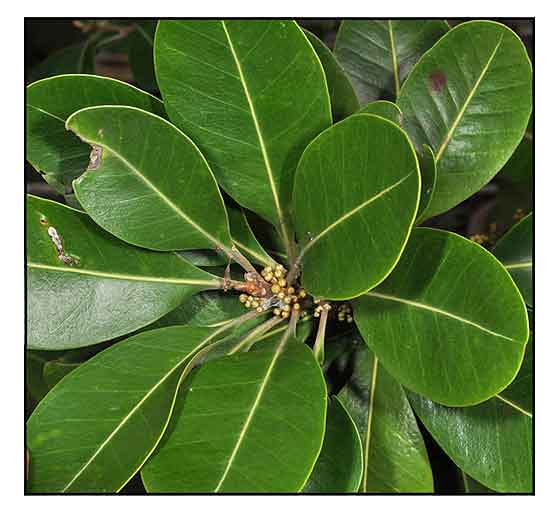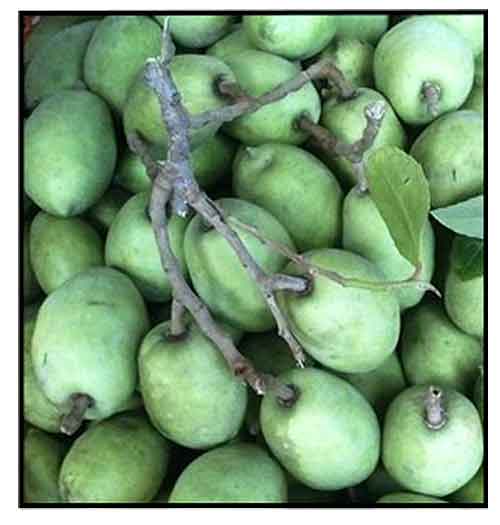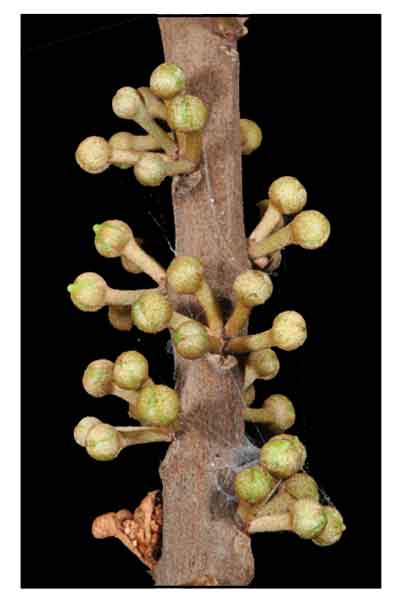
Family • Sapotaceae
Banasi
Planchonella obovata (R.Br.) Pierre
YELLOW BOXWOOD / SEA GUTTA
Shan lan
| Scientific names | Common names |
| Achras obovata F. Muell. ex Benth. | Banasi (Tagalog) |
| Chrysophyllum acuminatum Bojer. | Bungalong (Ilokano) |
| Chrysophyllum obovatum Wall. ex A.DC. | Mangkas (Sulu) |
| Homogyne cochinchinensis Dubard | Black ash (Engl.) |
| Planchonella argentea Pierre | Northern yellow boxwood (Engl.) |
| Planchonella attenuata (A.DC.) Pierre | Sea gutta (Engl.) |
| Planchonella bancana (Burck) Pierre | Yellow boxwood (Engl.) |
| Planchonella chrysophylla (de Vriese) Pierre | Yellow teak (Engl.) |
| Planchonella clarkeana R.Kumari & Thoth. | |
| Planchonella cochinchinensis Dubard | |
| Planchonella ferruginea (Hook. & Arn.) Pierre | |
| Planchonella glabra (Ridl) H.J.Lam | |
| Planchonella indica (Burck) Pierre | |
| Planchonella javensis (Burck) Pierre | |
| Planchonella kingiana R.Kumari & Thoth. | |
| Planchonella kingiana var. andamanica R.Kumari & Thoth. | |
| Planchonella lanceolata (Burck) Pierre | |
| Planchonella merrillii Dubard | |
| Planchonella nodosa (Burck) Pierre | |
| Planchonella obovata (R.Br.) Pierre | |
| Planchonella obovata var. dubia (Koidz. ex Nakai) Hatus. | |
| Planchonella philippensis Dubard | |
| Planchonella polymorpha Dubard | |
| Pouteria clarkeana (R.Kumari & Thoth.) R.Kumari & Thoth. | |
| Pouteria glabra (Ridl.) I.M.Turner | |
| Pouteria kingiana (R.Kumari & Thoth.) R.Kumari & Thoth | |
| Pouteria obovata (R.Br.) Baehni | |
| Pouteria obovata var. dubia (Koidz. ex Nakai) H.Hara | |
| Sersalisia ferruginea (Hook. & Arn.) Nakai | |
| Sersalisia liukiuensis (Nakai) Nakai | |
| Sideroxylon ahernianum Merr. | |
| Sideroxylon apoense Elmer | |
| Sideroxylon argenteum Spreng. | |
| Sideroxylon attenuatum A.DC. | |
| Sideroxylon bancanum Burck | |
| Sideroxylon brownii F.Muell. | |
| Sideroxylon chrysophyllum de Vriese | |
| Sideroxylon coriaceum Merr. | |
| Sideroxylon dubium Koidz. ex Nakai | |
| Sideroxylon ferrugineum Hook. & Arn. | |
| Sideroxylon glabrum Ridl. | |
| Sideroxylon glomeratum Volkens | |
| Sideroxylon indicum Burck | |
| Sideroxylon javense Burck | |
| Sideroxylon lanceolatum Burck | |
| Sideroxylon liukiuense Nakai | |
| Sideroxylon merrillii (Dubard) Merr. | |
| Sideroxylon indicum Burck | |
| Sideroxylon nodosum Burck | |
| Sideroxylon novoguineense K.Schum. | |
| Sideroxylon obovatum Griff. | |
| Sideroxylon obovatum Burck | |
| Sideroxylon obovatum var. ceramense Burck | |
| Sideroxylon philippense (Dubard) Merr. | |
| Sideroxylon timorense Blume ex Pierre | |
| Sideroxylon undulatum Burck | |
| Planchonella obovata is an accepted species. KEW: Plants of the World Online | |
| Other vernacular names |
| CAMBODIA: Rom denh. |
| INDONESIAN: Nyatu karikit, Jengkok, Nyatoh gambir, Gumbirar merah, Pelawan-pelawan. |
| MALAYSIA: Nyatoh laut, Menasi, Mensasi, Misi, Umas-umas, Pokok barat laut, Pulau dammar, Tuak-tuak. |
| THAILAND: Chan thit so, Phang ka bok, Nga sai, Surat. |
| VIETNAM: Moc, Cay trung ga. |
Botany
Constituents
Availability |
August 2023
![]()
 |
| PHOTOS / ILLUSTRATIONS |
| IMAGE SOURCE: Sapotaceae : Planchonella obovata / Twig with flower buds / Copyright © 2012 by P B Pelser & J F Barcelona (contact: [email protected]) [ref. DOL44568] / Non-Commercial Use / image modified / click on image or link to go to source page / Phytoimages.siu.edu |
| OTHER IMAGE SOURCE: Planchonella obovata / Fruits / © English-Khmer / click on image or link to go to source page / image modified / Noncommercial use / Chanbokeo |
| OTHER IMAGE SOURCE: Sapotaceae : Planchonella obovata / Flower buds / Copyright © 2012 by P B Pelser & J F Barcelona (contact: [email protected]) [ref. DOL44571] / Non-Commercial Use / image modified / click on image or link to go to source page / Phytoimages.siu.edu |
| OTHER IMAGE SOURCE: Planchonella obovata / Flowering stem/ © M Fagg / Australian National Botanic Garden / click on image or link to go to source page / image modified / Noncommercial use / Useful Tropical Plants |
Additional
Sources and Suggested Readings |
• |
DOI: It is not uncommon for links on studies/sources to change. Copying and pasting the information on the search window or using the DOI (if available) will often redirect to the new link page. (Citing and Using a (DOI) Digital Object Identifier) |
| List of Understudied Philippine Medicinal Plants |
• |
 |


 • Planchonella obovata is a shrub or tree, to 40 m tall but usually shorter. Bark brown. Branchlets angulate, rust colored sericeous to tomentose when young, glabrescent. Leaves scattered; petiole 0.5--5 cm; leaf blade obovate to lanceolate, 6--24 X 1.5--15 cm, membranous, papery, or leathery, abaxially rust colored, blackish tomentose, or sericeous but glabrescent, adaxially shining and glabrous, base narrowly to broadly cuneate, apex rounded to acuminate, lateral veins 7--18 pairs. Flowers female or bisexual, green to white, several in axillary clusters, 5- or 6-merous. Pedicels 2--10 mm, rust colored and white tomentose. Sepals 5(or 6), rounded or broadly ovate, 2--3 X 2--3 mm, outside white, yellow, or rust colored tomentose, inside glabrous, margin membranous, ciliate, or fimbriate. Corolla campanulate, 3--5 mm; lobes 5, broadly ovate to oblong. Stamens 2.5--3.5 mm, sometimes absent or abortive; staminodes lanceolate to triangular, sometimes absent. Ovary conical to obovoid, rust colored hirsute, 5--10-locular. Style conical, 1.5--2 mm, 5-ribbed. Fruit white, yellow, red, or blue when fresh, obovoid to globose, 1--1.5 X 1--1.5 cm; pericarp membranous, glabrous; 1--5-seeded. Seeds oblique fusiform, 8--12 X 2--3.5 mm, yellow; scar narrowly elliptic. (
• Planchonella obovata is a shrub or tree, to 40 m tall but usually shorter. Bark brown. Branchlets angulate, rust colored sericeous to tomentose when young, glabrescent. Leaves scattered; petiole 0.5--5 cm; leaf blade obovate to lanceolate, 6--24 X 1.5--15 cm, membranous, papery, or leathery, abaxially rust colored, blackish tomentose, or sericeous but glabrescent, adaxially shining and glabrous, base narrowly to broadly cuneate, apex rounded to acuminate, lateral veins 7--18 pairs. Flowers female or bisexual, green to white, several in axillary clusters, 5- or 6-merous. Pedicels 2--10 mm, rust colored and white tomentose. Sepals 5(or 6), rounded or broadly ovate, 2--3 X 2--3 mm, outside white, yellow, or rust colored tomentose, inside glabrous, margin membranous, ciliate, or fimbriate. Corolla campanulate, 3--5 mm; lobes 5, broadly ovate to oblong. Stamens 2.5--3.5 mm, sometimes absent or abortive; staminodes lanceolate to triangular, sometimes absent. Ovary conical to obovoid, rust colored hirsute, 5--10-locular. Style conical, 1.5--2 mm, 5-ribbed. Fruit white, yellow, red, or blue when fresh, obovoid to globose, 1--1.5 X 1--1.5 cm; pericarp membranous, glabrous; 1--5-seeded. Seeds oblique fusiform, 8--12 X 2--3.5 mm, yellow; scar narrowly elliptic. (

